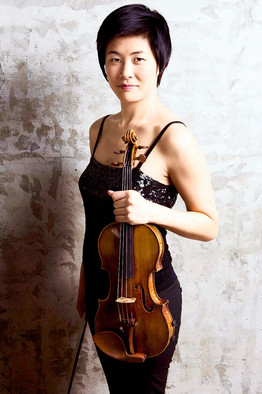The Wall Street Journal
By Stuart Isacoff
January 29, 2011
original
link
A Violinist on a Solo Mission:
Koh Takes On the Challenge of Proving the Instrument Can Hold Center Stage

Fran Kaufman
Violinist Jennifer Koh has been called a
'risk-taking, high-octane player.'
Long before the era of megavolume amplifiers and string-bending Stratocaster guitars, the instrument that really rocked the concert stage was the violin.
Picture the great master of the instrument, Niccolò Paganini, in the 1830s. Described by Hector Berlioz as "a man with long hair, piercing eyes and a strange, ravaged countenance," Paganini played with such fire that audiences believed he was in league with the devil. "He threw me into hysterics," confessed Mary Shelley.
These are tamer times for classical music, and the violin recital is most often a genteel event—a banquet of spun-sugar melodies served over warm piano tones.
But not for violinist Jennifer Koh, cited by the Strad magazine as a "risk-taking, high-octane player."
At the 92nd Street Y on Sunday, Ms. Koh will be performing an unaccompanied solo violin recital, a format rarely encountered these days.
"People tell me I'm crazy, because it's very difficult to play solo for an entire concert," says Ms. Koh, 34 years old. "But it's not unusual to find a solo piano program. I wanted to show that the violin is just as intellectual and interesting and has as much color and timbre as the piano. After doing this in a number of places, I discovered that many reviews said, 'After a while, you didn't realize that the violin was alone.' Of course, programming is always key in being able to create an adventure with the audience. And it has to be an adventure that I want to take as well. Every single piece on the program is something I'd be happy to live with for the rest of my life."
The program is titled "Bach and Beyond," and it draws connections between the masterly works of J.S. Bach and later composers influenced by him.
"Last year, I was lucky to play Bach's solo sonatas and partitas as part of Miller Theatre's lunchtime programs at Columbia University's Philosophy Hall," she says. "From that, I developed this concept. It's astounding to me that music Bach wrote over 200 years ago is still so relevant and moving. There is something so human, but also transcendent, in his music. I want to explore why, to discover how his art is a reflection of who we are."
The concert will begin with Bach's Partita No. 3 in E Major, followed by Romantic-era Eugène Ysaÿe's Sonata No. 2 in A minor, which quotes the Partita as well as the Dies Irae plainchant from the Mass for the dead.
The concert will end with Esa-Pekka Salonen's "Lachen verlernt" ("I've Forgotten How to Laugh") and Bach's Partita No. 2 in D Minor. Those musical bookends will frame works by two formidable contemporary voices, Kaija Saariaho (a work in memory of Witold Lutosławski) and Elliott Carter (with music in memory of Roger Sessions).
"The Salonen suggests the Bach because it is in the form of a chaconne," explains Ms. Koh. "It takes its title from Schoenberg's 'Pierrot Lunaire,' in which a character asks Pierrot to help him rediscover how to laugh. The music is about traveling from light to darkness and back to light again."
The Salonen work is also the only one on the program that includes accompaniment—but not of the audible kind. Instead, it will present the New York premiere of a video by Tal Rosner created for this piece.
"I wanted to include Tal's work," says Ms. Koh, "because for me, the concert experience is a living piece of art. I knew that adding a visual element would provide another dimension."
"She's a real visionary," says Mr. Rosner. "Jenny foresees the future, and feels entrusted to give the audience a multifaceted experience."
The musical concept is Ms. Koh's heartfelt offering to a world in which, as the late writer John Gardner put it, art is our only "tragic-comic holding action against entropy." "Art rediscovers, generation by generation, what is necessary to humanness," he asserted in "On Moral Fiction."
Ms. Koh expresses similar sentiments. "I grew up in a time when people were declaring classical music to be dead," she explains. "And yet I felt such a strong connection to this music. It was very much alive to me. As a musician, I had to find a validation. Musical programs are like rituals in which we can all evolve in a shared journey."
—Mr. Isacoff is on the faculty of the Purchase College Conservatories of Music and Dance (SUNY), and author of "Temperament: How Music Became a Battleground for the Great Minds of Western Civilization."
© 2011 The Wall Street Journal
© Jennifer Koh, All Rights Reserved. Photography by Juergen Frank. Site by ycArt design studio